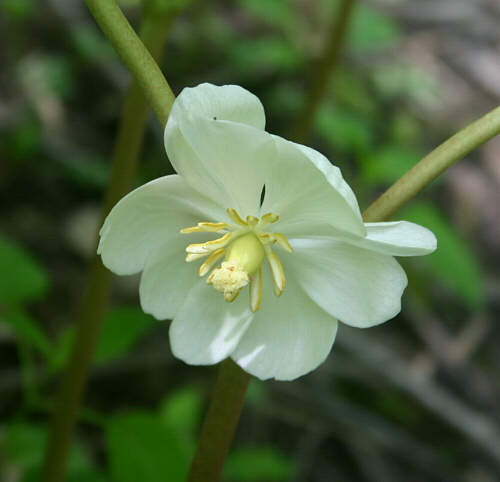I recall winding up one of our nature walks at DeKorte a few years back when a very nice woman stopped to ask me, “What are those strange plants that look like little green umbrellas growing alongside the building?” “You mean the turtle umbrellas?” I asked with a smile. While they may not actually be turtle umbrellas, they are a great native perennial that by the way really are an important food source to Eastern Box turtles.
Blanketing the forest floor in places like Losen Slote Creek and even in shaded areas of DeKorte Park, Mayapples (Podophyllum peltatum), are one of those natives plants that never fail to make me smile and remind me why I love our native flora so much. (I think in reality they are actually Gnome umbrellas).
Mayapple is an early woodland wildflower that stands about a foot tall, with palmately lobed umbrella-like leaves that typically colonize to cover large parts of the forest floor. While some backyard gardeners may not love for its wandering ways I think that is one of its best traits, especially when you are trying to restore the ecology of the forest floor. Besides, in my humble opinion, having just one green umbrella in your yard would just look out of place.
If you are lucky enough to stumble upon Mayapple and your timing is right take a peak under the leaves and you might just get a glimpse of the large lovely white flower hiding under the shady little parasols. The flowers with their musky scent lack nectar but offer our native bees an abundant pollen prize when there are not many other flowers available.
The mature fruits of the Mayapple are eaten by Eastern Box Turtles, which may be the main distributor of the seeds. They are also eaten by such mammals as opossums, raccoons, squirrels and skunks. Recently I read that birds like grackles may also like to dine on the little morsels that resemble a small, lemon-colored egg-shaped fruit hat are about one-and-a-half to two inches long. And if you are in bear country they don’t mind munching a Mayapple now and then either.
Now for a warning. Mayapple is both poisonous and edible. Yes you heard correct. All parts of the plants are very toxic except the fruit but ONLY WHEN RIPE. Folks that have tried say it tastes like ripe melon and they say it makes a good jam (personally I don’t think I will be taking any chances).
So while Mayapple might be a good addition to your backyard woodland garden you might think twice if you have children or pets that might decide to sample the backyard cuisine!
Mayapple has a long history of being used as a medicinal plant as well. Roots of the Mayapple were used by Native Americans and early settlers as a “liver cleanser” and worm expellant. Roots were also used to treat jaundice, constipation, hepatitis and fevers. Today it has been used for treatment for warts as well as a treatment for cancer.
If you decide to introduce Mayapple to you backyard it prefers dappled sunlight to light shade, moist to slightly dry conditions and a rich loamy soil with abundant organic matter.
Every native plant plays an important role in the biodiversity of the forest. Preserving and protecting them is just as important to the health of our environment as the Eagle or the Falcon.



